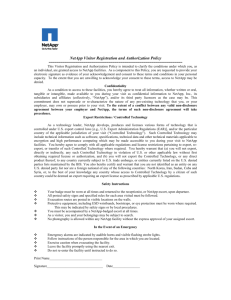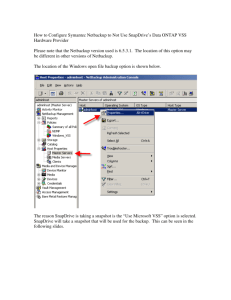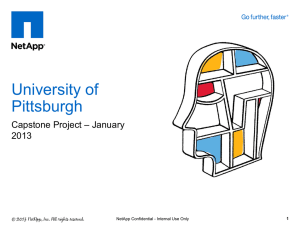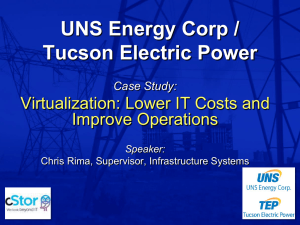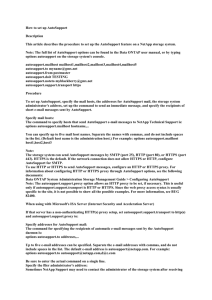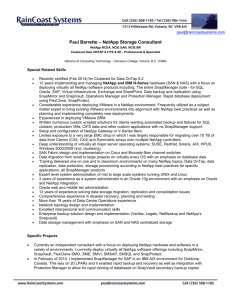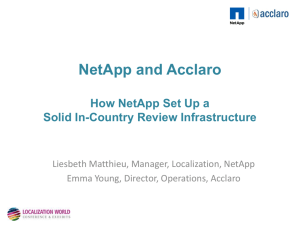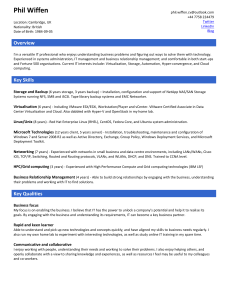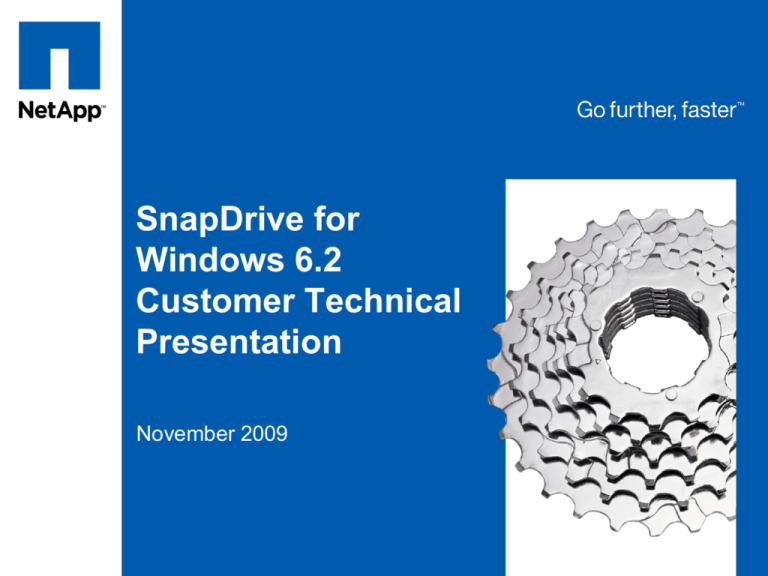
Tag line, tag line
SnapDrive for
Windows 6.2
Customer Technical
Presentation
November 2009
Agenda
Welcome to SnapDrive 6.2
–
–
–
–
–
Windows Hyper-V Support
Cluster Shared Volumes
Additional Support for VMware
File Level Restore
Role-based Access Control
Summary and Q&A
© 2009 NetApp. All rights reserved.
Confidential – Limited Use
© 2008 NetApp. All rights reserved.
2
NetApp Manageability Software Family
An Integrated Data Management Approach
SnapManager®
for Exchange
SnapManager for
SharePoint® Server
SnapManager
for SAP®
Database Suite
SnapManager
for SQL Server ®
SnapManager
for Oracle®
Server Suite
SnapManager for
Virtual Infrastructure
SnapManager
for Hyper-V®
SnapDrive® for
Windows®, UNIX®, Linux®
Service Layer
Security and Access Control
Application Suite
Storage Suite
System
Manager
Operations
Manager
Provisioning
Manager
Protection
Manager
Open Interfaces
© 2008 NetApp. All rights reserved.
3
Platform Support at a Glance
Windows 2003 SP2
®
Windows 2008
Windows 2008 R2
Windows 2008 Hyper-V
®
VMware 3.5 Update 4 or later
®
.NET 3.5 SP1 or later
Supports both FC and iSCSI connections
Windows clusters up to 8 nodes
© 2008 NetApp. All rights reserved.
4
SnapDrive GUI – Centralized Management
Multi-host
Management
Context
Sensitive
Actions
SnapDrive®
Host
LUNs/
Disks
Disk Details
© 2008 NetApp. All rights reserved.
5
What’s New in SnapDrive for Windows 6.2?
Windows® Server 2008 R2 Hyper-V®
– Support for hot add/delete of pass-through LUNs
– Support for Cluster Shared Volumes (CSV)
VMware®
– Support for ESX iSCSI and iSCSI HBA initiators
– Support for RDM LUNs using VMware ESX iSCSI initiators
– Support for creating MSCS using FC RDM LUNs
on Windows Server 2003 and 2008
File-level restore
– Restore of files, directories, and
subdirectories
– APIs are available for custom calls to applications
– File restore operation a LUN or LUNs
What’s
New?
Role-based Access Control (RBAC)
– Support for RBAC policies set with Operations Manager
© 2008 NetApp. All rights reserved.
6
Microsoft Windows
Hyper-V Support
2009NetApp.
NetApp. All
Allrights
rightsreserved.
reserved.
©©2008
7
Hyper-V Hardware and Software
Requirements
Windows Server 2008 R2 is required on the
Hyper-V Server
®
®
Data ONTAP 7.3.1 is required on the storage system
®
SnapDrive for Windows 6.2 is required on the parent
operating system as well as the guest operating
systems
®
The Microsoft® virtual SCSI controller must be present
on the virtual machine
– This is by default on Server 2008 R2
For iSCSI pass-through LUNs, the iSCSI session must
already be established on the parent operating system
.Net 3.5 on Hyper-V virtual machine
© 2008 NetApp. All rights reserved.
8
Hyper-V Hardware and Software
Requirements
The initiator screens on the disk create, disk connect, and
snap mount MMC wizard show a new window for passthrough LUNs
This screen only appears if the dedicated disk type is
selected and if the Enable option was selected during the
SnapDrive installation
on the Hyper-V™ VM
®
– Hot add/delete
does not yet support
shared pass-through
disks
© 2008 NetApp. All rights reserved.
9
Dynamically Provision Pass-through LUNs
SnapDrive 6.2 allows hot add and delete of
LUNs on Hyper-V VMs
®
™
– Allows dynamic attach and detach of NetApp storage
to and from the virtual SCSI controller on the VM
®
– Dynamic attach and detach does not require a reboot
– Allows provisioning of LUNs from FCP and
iSCSI initiators on the Hyper-V parent
– Operations are performed from the VM without any
administration needed on the Hyper-V parent
Supports standalone and failover cluster VMs
© 2008 NetApp. All rights reserved.
10
Hyper-V Pass-through LUN Management
LUN managed at Hyper-V VM console
™
– Allows create/connect from Hyper-V VM
– SnapDrive console shows pass-through information from
both Hyper-V parent and Hyper-V VM
®
Hyper-V VM
View of Passthrough LUNs
Hyper-V Parent
View of Passthrough LUNs
© 2008 NetApp. All rights reserved.
11
Cluster Shared
Volumes
2009NetApp.
NetApp. All
Allrights
rightsreserved.
reserved.
©©2008
1212
What Is a Cluster Shared Volume (CSV)?
Cluster Shared Volume (CSV) is a new feature
within Failover Clustering in Windows Server
2008 R2
®
– Enables access to files on shared storage from
all nodes at the same time
– Provides the same namespace for each volume
and ensures that the namespace is consistent
across all nodes of the Failover Cluster
Supported for Windows 2008 R2
™
Supported for Hyper-V purposes
© 2008 NetApp. All rights reserved.
13
Cluster Shared Volume Architecture
VM 1 VM 2
VM 3 VM 4
Cluster Shared
Volume Reroutes
I/O Based on
Connection Availability
Cluster Node 1
Cluster Node 2
Storage
Area Network
Cluster Shared
Volume
VM1 VHD VM2 VHD VM3 VHD
© 2008 NetApp. All rights reserved.
VM4 VHD
14
Cluster Shared Volume LUN Summary View
© 2008 NetApp. All rights reserved.
15
Additional Support
for VMware
2009NetApp.
NetApp. All
Allrights
rightsreserved.
reserved.
©©2008
1616
Added Support for VMware iSCSI
Support for ESX iSCSI and iSCSI HBA initiators
in SnapDrive® 6.2
Perform LUN provisioning and snapshot management operations
Enumerate ESX iSCSI initiators using CLI and GUI
Support Window 2003 server-SP2 (x86 and x64) and Windows
2008 Server as GuestOS
®
Support VMotion , if LUNs are connected through ESX iSCSI and
iSCSI HBA initiators
®
Create igroup using ESX iSCSI and iSCSI HBA initiators
Allow user to select igroup which contains multiple ESX iSCSI
and iSCSI HBA initiators from different ESX servers
A maximum of 56 LUNs supported in GuestOS (both FCP
and iSCSI)
© 2008 NetApp. All rights reserved.
17
Support for VMware iSCSI – How It Works
SnapDrive will be able to provision the LUN
using ESX SW iSCSI and iSCSI HBA initiators
®
It will enumerate the ESX SW iSCSI and iSCSI
HBA initiator iQN
LUN will be mapped to igroup containing ESX
SW iSCSI and iSCSI HBA initiator
Rescan HBA, ESX will able to see the
mapped LUN
Now this LUN will be presented to the
GuestOS through RDM
© 2008 NetApp. All rights reserved.
18
Support for VMware MSCS
SnapDrive 6.2 now supports VMware MSCS
across the box cluster using FC RDM LUNs
®
®
Operating System
Service
Pack
ESX Server
Windows 2003
32bit/64bit
SP2
ESX 3.5 and later
Windows 2008
Enterprise/
Datacenter Server
-
ESX 4.0
© 2008 NetApp. All rights reserved.
19
VMware ESX Shared FC Disk
Create a LUN on the storage system and map it to an
igroup containing both ESX servers’ FC initiators
Create a RDM for the disk on node 1 (VM on first ESX
server)
– Select a SCSI controller in physical compatibility mode to
attach this RDM
– After this step, the disk is exposed to GuestOS on node 1
Format the disk and create NTFS partitioning
– Assign a drive letter to the disk on node 1
Assign the disk to a Cluster Resource Group on node 1
Now connect to the shared RDM disk which is on node 1
and make it available to node 2 (VM on the second ESX
server)
In this way, the FC RDM disk is shared between the two
nodes
© 2008 NetApp. All rights reserved.
20
File Level Restore
2009NetApp.
NetApp. All
Allrights
rightsreserved.
reserved.
©©2008
2121
File Level Restore
Allows restore of individual files, sets of files,
directories, or a directory and all its sub
directories
– Single files, sets of files, or directories
– APIs available custom application calls
– SDCLI based
SDCLI snap restore [-m <MachineName>] {-d <MountPoint> -s
<SnapshotName>} || { -flr [-copy] {-s <SnapshotName> -files
<filepath>[...] }+ }
MachineName - Optional. If not provided will use local machine
SnapshotName - Name of the backup snapshot from which to restore
-flr - Selects file level restore
-copy - Optional - this is the option to force copy-restore
-files - Means the filepath args are files to restore
filepath - List of "destination" filepath, including the mount point details
© 2008 NetApp. All rights reserved.
22
File Level Restore in Depth
Users can perform restore operations
on individual files, sets of files,
directories, or a directory and all its
subdirectories
SDCLI interface is the primary user-level interface
No graphical user interface is provided for this feature
APIs are available to calling applications such as
SnapManager for Hyper-V
®
®
The File Level Restore function will perform restore
operations on a LUN or LUNs as directed by the list of
files and or directories listed after the -files switch in
the sdcli command
© 2008 NetApp. All rights reserved.
23
File Level Restore of VMs
Can take Snapshot™ copies of VMs
via VSS or SnapDrive®
– VSS Snapshot copies capture consistent Snapshot
copies of live VM
– SnapDrive Snapshot copies require VM to be down
Can restore Snapshot copies of virtual machines
– Can restore from VSS or SnapDrive Snapshot copies
– VMs must be down when restored
– Both the .vhd file and the VM directory must be restored
together
© 2008 NetApp. All rights reserved.
24
Role-based Access
Control (RBAC)
2009NetApp.
NetApp. All
Allrights
rightsreserved.
reserved.
©©2008
2525
RBAC with Operations Manager
SnapDrive 6.2 RBAC
®
– Conforms with policies set on Operations Manager
– SnapDrive contacts Operations Manager to check
for requisite permissions before proceeding with a
given operation
– SnapDrive is the Policy Enforcement Point (PEP)
Operations Manager
– Requires Operations Manager 3.7
and above
– Requires SnapDrive to conform
with policies
– Operations Manager is the Policy
Decision Point (PDP)
© 2008 NetApp. All rights reserved.
26
Enabling RBAC with SnapDrive 6.2
SnapDrive 6.2 RBAC setup methods
®
– Can configure SDW during initial installation
– Can configure via sdcli if SDW already installed
© 2008 NetApp. All rights reserved.
27
RBAC: Roles in Effect
SnapDrive view is based on RBAC permissions
set for the Windows login user
®
®
© 2008 NetApp. All rights reserved.
28
RBAC: Policies Applied
© 2008 NetApp. All rights reserved.
29
Summary
2009NetApp.
NetApp. All
Allrights
rightsreserved.
reserved.
©©2008
3030
Summary of SnapDrive for Windows 6.2
Windows Server 2008 R2 Hyper-V™
®
– Support for hot add/delete of pass-through LUNs
– Support for Cluster Shared Volumes (CSV)
VMware
®
– Support for ESX iSCSI and iSCSI HBA initiators
– Support for RDM LUNs using VMware ESX iSCSI initiators
– Support for creating MSCS using FC RDM LUNs on Windows
Server 2003 and 2008
Role-based Access Control (RBAC)
– Support for RBAC policies set with Operations Manager
File Level Restore
– Restore of files, directories, and sub directories
– APIs are available for custom calls to applications
– File Restore operation on LUN or LUNs
© 2008 NetApp. All rights reserved.
31
Thank You –
Questions?
© Copyright 2009, NetApp, Inc. All rights reserved. No portions of this document may be reproduced without prior written
consent of NetApp, Inc. Specifications are subject to change without notice. NetApp, the NetApp logo, Go further, faster,
Data ONTAP, FlexClone, SnapDrive, SnapManager, SnapMirror, Snapshot, SnapVault, and Virtual File Manager are
trademarks or registered trademarks of NetApp, Inc. in the United States and/or other countries. Solaris is a trademark of
Sun Microsystems, Inc. Microsoft, Windows, SQL Server, and SharePoint are registered trademarks and Hyper-V is a
trademark of Microsoft Corporation. SAP is a registered trademark of SAP AG. Oracle is a registered trademark of Oracle
Corporation. UNIX is a registered trademark of The Open Group. Linux is a registered trademark of Linus Torvalds.
VMware is a registered trademark of VMware, Inc. All other brands or products are trademarks or registered trademarks of
their respective holders and should be treated as such.
© 2009
2008 NetApp. All rights reserved.
3232


